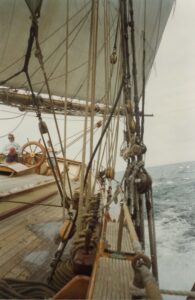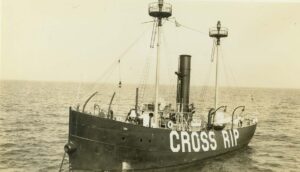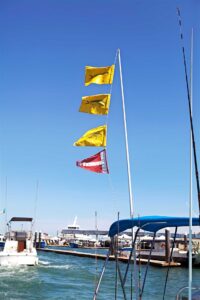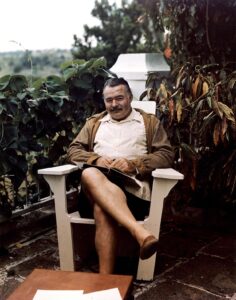In 1970, during my first visit to the Canadian Maritime Provinces, I spent a week touring Prince Edward Island. At that time, a sailor could pass the day ashore at the community lobster dinner at St. Anne’s Church or buy a postcard depicting a giant potato resting on a flatbed railroad car to mail back home. Unbeknownst to me, since my boyhood reading consisted of comic books and the complete Hardy Boys series, was the story of Anne of Green Gables.
First published in 1908, by Canadian author Lucy Maud Montgomery, Anne of Green Gables went through 10 printings in that first year. At that time, it was a bestseller of epic proportion. Today, it has been translated into 20 different languages and has sold over 50 million copies worldwide. The book recounts the story of Anne Shirley, an 11-year old redheaded girl in pigtails, orphaned in Nova Scotia and sent to Prince Edward Island for adoption. With a twist worthy of Gilbert and Sullivan, Anne’s adopted family, the Cuthberts, were expecting to be sent a boy for adoption to help out on the family farm. Middle-age siblings Marilla and Matthew Cuthbert lived at Green Gables, a white wood framed farmhouse with gables painted a rich green color. The brother and sister decided that young Anne should stay on the farm, go to the country school in Avonlea and grow into a promising young woman.
Green Gables farm actually exists and it is the most notable literary landmark on Prince Edward Island, if not all of Canada. The farm is now known as the Green Gables Heritage Center, and the white and green house was designated a National Historic Site of Canada in 1985. Rural Avonlea depicted in the novel, is really the town of Cavendish, now Prince Edward Island’s most popular tourist destination.
The author, who preferred to be called Maud Montgomery, was born on Prince Edward Island in 1874, and at age 2 was left in the care of her grandparents after her mother died. Maud’s grandparents had a small home in Cavendish where she spent her formative years. About a half-mile away lived her cousins, the MacNeill family, at Green Gables farm, and Maud visited their house often.
Maud eventually went to college and became a teacher in a town on Prince Edward Island some 25 miles away from Green Gables. She returned to Cavendish once again in 1898 to help her grandmother after her grandfather passed away, living once again in her childhood home. It was then and there that she wrote Anne of Green Gables. “I wrote it in the evenings after my regular day’s work was done,” Maud recalled, “wrote most of it at the window of the little gable room that had been mine for many years.”
Prince Edward Island, situated between Nova Scotia and New Brunswick, was granted to Great Britain as a spoil of war from France in 1763. Just over a hundred years later, its capital Charlottetown, hosted the first meeting in the process that led to the creation of the confederation of Canada. Prince Edward Island became part of Canada in 1873, the year before Maud Montgomery was born and at the height of the Victorian era.
In 1911, three years after Anne of Green Gables was published, Maud Montgomery married and the couple moved to Ontario, where Montgomery spent the rest of her life. She did revisit the island on occasion, and those wistful visits helped her to write sequels to her original novel. When Montgomery died in 1942 she had written nine other books that featured Anne Shirley at different stages of her life. The original story was portrayed on the big screen as a silent movie in 1919, and then remade as a “talkie” in 1934.
Today, the Anne of Green Gables franchise includes 12 made-for-TV movies, five television series, five theatrical musicals (including the Canada’s longest running stage musical), six radio dramas, and two Web series. In the works for this year and next are a new feature film and a new television movie.
The country of Japan has a special affinity to the character of Anne Shirley. Since 1952, reading Anne of Green Gables, under the Japanese title of Red-Haired Anne, has been part of the national school curriculum. Many Japanese couples travel to Prince Edward Island to get married on the grounds of Green Gables farm. And some Japanese girls even arrive with their hair dyed red and in pigtails to emulate the young Anne.
Arriving by boat, whether in pigtails or not, the best source for American cruisers on finding information about Prince Edward Island marinas is the website Welcoming Waters (boatingpei.com). This online resource gives an overview of the 14 marinas on the island and is maintained by the Prince Edward Island Recreational Marinas Association (PEIRMA). These marinas circle the island completely, but they vary on the
number of transient slips available and the maximum length overall accommodated. After reviewing the PEIRMA website, contact a Marinalife concierge to arrange your dockage reservation.
Before setting sail for Prince Edward Island, it’s a must that everyone on board read or reread Anne of Green Gables. Carry it along during your tour of novel’s many island settings, and let it be your guidebook to those idyllic Victorian times.
Capt. Jeff Werner has been in the yachting industry for over 25 years. In addition to working as a captain on private and charter yachts, both sail and power, he is a certified instructor for the USCG, US Sailing, RYA and the MCA. He is also the Diesel Doctor, helping to keep your yacht’s fuel in optimal condition for peak performance. For more information, call 239-246-6810, or visit MyDieselDoctor.com. All Marinalife members receive a 10% discount on purchases of equipment, products and supplies from Diesel Doctor.





